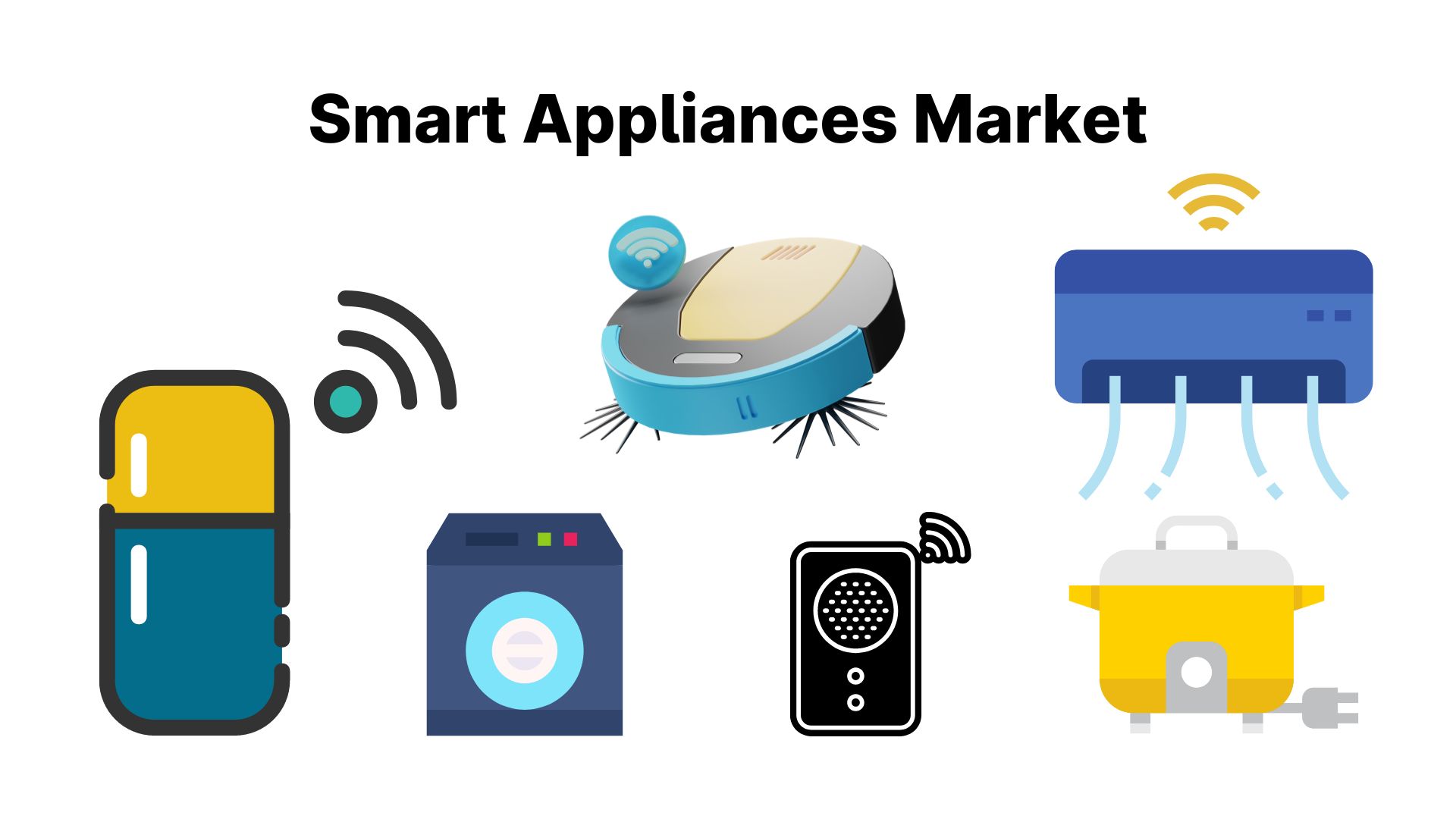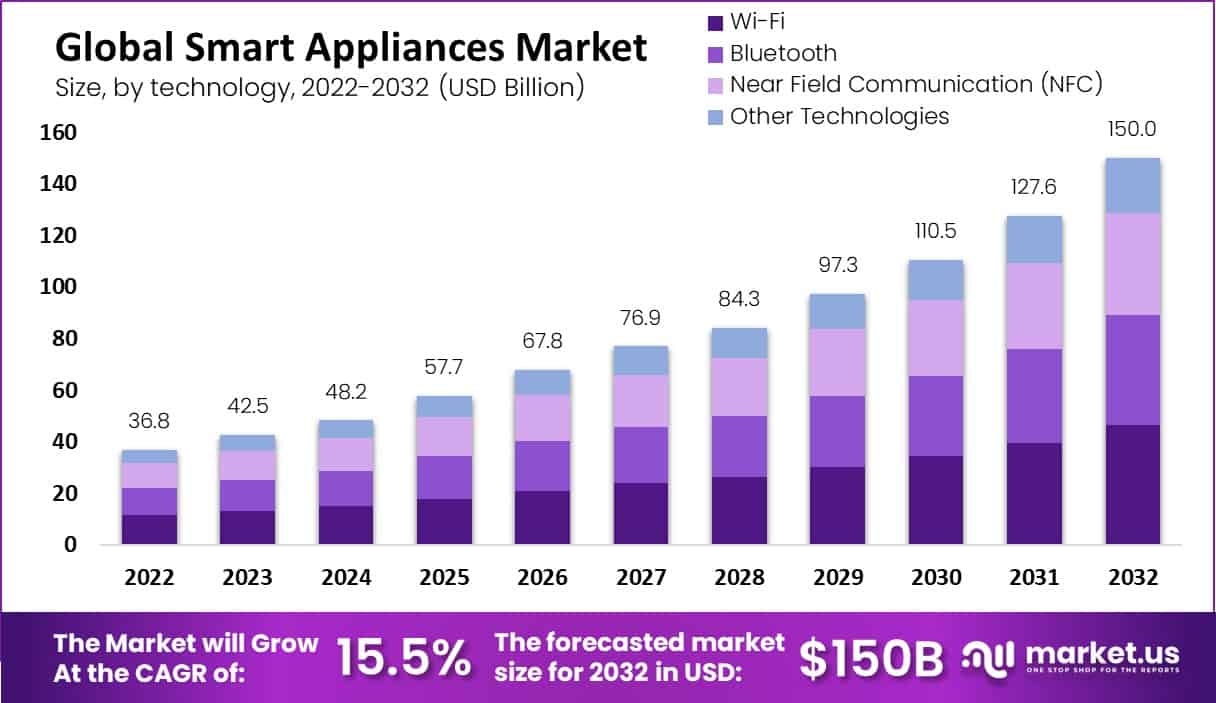Smart Appliances Market Size to Reach USD 150 Bn By 2032 | Growing at CAGR of 15.5%

Page Contents
Market Overview
Published Via 11Press : The smart appliances market was experiencing steady growth and was projected to continue doing so in the years ahead. Smart appliances can be defined as those connected to the internet and controlled remotely through devices like smartphones and other connected devices – these appliances provide various benefits including increased convenience and energy efficiency.
In 2022, the global smart appliances market was valued at USD 36.8 billion and is projected to reach approximately USD 155.5 billion by 2032, expanding at an estimated compound annual growth rate of 15.5% from 2023-2032. Increased demand for smart homes coupled with their growing adoption are driving this market growth.
Geographically, Asia Pacific is anticipated to experience the fastest compound annual growth in smart appliances during this forecast period due to an expanding population and rising disposable incomes in countries such as China and India. North America and Europe should also experience significant expansion within their respective smart appliance markets.
As for product types, smart refrigerators and washing machines are expected to lead the market due to their increasing popularity and the growing need for energy-efficient devices.
Overall, the smart appliances market is projected to experience substantial expansion in the coming years due to increasing adoption of smart home technology and increasing demand for energy-efficient products.\

Get a glance of the market contribution of various segments including country and region wise –Download a sample report
Key Takeaways
- In 2022, the global smart appliances market was estimated at USD 36.8 billion and is projected to experience compound annual compound annual growth rate of 15.5% from now until 2032.
- Smart refrigerators and washing machines are expected to dominate the smart appliances market due to their increasing popularity as energy-saving appliances.
- Asia Pacific is projected to experience the highest compound annual growth in smart appliances over the forecast period, followed by North America and Europe.
- Rising demand for smart homes and the rising adoption of connected technologies are driving growth of the smart appliance market.
- Other factors, including government initiatives to promote energy-efficient appliances, rising disposable incomes and growing awareness about smart appliance benefits should help drive the smart appliance market's expansion.
Regional Snapshot
- Asia Pacific: This region is projected to experience the highest compounded compound growth rate over the forecast period, due to factors like an increasing population, increasing disposable incomes, and demand for energy-saving appliances in countries like China and India.
- North America: The North American market for smart appliances is projected to experience substantial expansion, due to increased adoption of smart home technology and increasing demand for energy-efficient appliances.
- Europe: The smart appliances market in Europe is expected to experience impressive growth, thanks to an increasing emphasis on energy conservation and an increase in awareness about their benefits.
- Rest of World: The smart appliance market in other regions should experience growth due to factors like urbanization, rising incomes, and growing adoption of smart home technology.
Drivers
- Growing Adoption of Smart Home Technology: With more consumers turning to smart home technologies for convenience and energy savings, consumers are increasingly searching for appliances they can remotely control as well as energy efficient appliances to add to their homes.
- Rising demand for energy-efficient appliances: As more consumers strive to reduce their impact on the planet, demand for energy-saving appliances continues to rise. Smart devices can assist consumers in meeting this objective.
- Government Initiatives Promoting Energy-Efficient Appliances: Many governments around the world are encouraging energy-efficient appliances through various initiatives, including tax credits and rebates, which should help drive market expansion for smart appliances.
- Rising disposable incomes: With increased disposable income, consumers become more willing to invest in appliances that offer greater convenience and energy efficiency, driving the expansion of the smart appliances market.
Restraints
- Restrictions and Challenges High cost: Smart appliances tend to be more costly than their counterparts, which may hinder adoption in developing nations where incomes may be limited.
- Security Concerns: Smart appliances connect to the internet, creating cybersecurity and privacy worries among consumers who may hesitate to adopt these appliances due to these worries.
- Limiting Access: Due to their relative newness, smart appliances may not yet be widely available across markets and may therefore hinder market expansion for smart appliances.
- Lack of Standardization: Due to a lack of standardization in the smart appliances market, interoperability issues may arise which make adoption of smart devices even harder for consumers.
Opportunities
- Rising Demand for Home Automation Systems: As demand for home automation systems continues to increase, so will demand for smart appliances that can integrate into these systems.
- Increased interest in Internet of Things (IoT): Smart appliances are key components of IoT, which is projected to experience rapid expansion over the coming years and offers significant market opportunities for the industry. This presents significant prospects for growth for smart appliances sales.
- Emergence of Smart Cities: With the proliferation of smart cities comes an opportunity for the smart appliances market, as smart appliances can help reduce energy consumption and enhance overall efficiency in these cities.
- Advances in technology: Thanks to advances like artificial intelligence and machine learning, smart appliances have become even more intelligent and efficient, creating new opportunities in the smart appliances market.
Challenges
- High cost: As previously discussed, high cost is one of the major obstacles to the smart appliance market in developing nations where incomes may be low.
- Security Concerns: Smart appliances also present security challenges to consumers who may be reluctant to adopt these appliances due to fears regarding cybersecurity and privacy issues.
- Lack of Standardization: Due to a lack of standards within the smart appliances market, interoperability issues may arise and make it more challenging for consumers to adopt these devices.
- Low consumer awareness: Awareness about smart appliances remains relatively low among the general population, which poses a challenge to the market. More education and awareness campaigns may be required in order to promote adoption rates.
Recent developments
- Advancements in voice-activated controls: Many smart appliances now offer voice-activated controls, allowing consumers to control their appliances using voice commands.
- Increased integration with smart home systems: Smart appliances are becoming more integrated with smart home systems, making it easier for consumers to control all of their smart devices in one place.
- Improved energy efficiency: Smart appliances are becoming even more energy efficient, helping consumers save money on their energy bills while reducing their carbon footprint.
- Greater focus on sustainability: Many smart appliance manufacturers are placing a greater focus on sustainability, using materials and manufacturing processes that are more environmentally friendly.
Key Market Segments
Based on Product
- Smart Washing Machine
- Smart Refrigerators
- Smart Air Purifiers
- Smart TV
- Other Products
Based on Technology
- Wi-Fi
- Bluetooth
- Near Field Communication (NFC)
- Other Technologies
Based on Distribution Channel
- Offline
- Online
Based on End-User
- Residential
- Commercial
Market Key Players
- Samsung Electronics Co. Ltd.
- Whirlpool Corp.
- LG Electronics
- Haier Group
- Panasonic Corp.
- BSH Hausgerate GmbH
- Electrolux AB
- Koninklijke Philips N.V.
- GE Appliances
- Xiaomi Corp.
- Other Key Players
Report Scope
| Report Attribute | Details |
| The market size value in 2022 | USD 36.8 Bn |
| Revenue forecast by 2032 | USD 155.5 Bn |
| Growth Rate | CAGR Of 15.5% |
| Regions Covered | North America, Europe, Asia Pacific, Latin America, and Middle East & Africa, and Rest of the World |
| Historical Years | 2017-2022 |
| Base Year | 2022 |
| Estimated Year | 2023 |
| Short-Term Projection Year | 2028 |
| Long-Term Projected Year | 2032 |
FAQs
What are smart appliances?
Smart appliances are appliances that can be connected to the internet and controlled remotely, offering greater convenience and energy efficiency.
What are the advantages of smart appliances?
Smart appliances offer greater convenience, energy efficiency, and control over traditional appliances.
Are smart appliances more expensive than traditional appliances?
Yes, smart appliances are generally more expensive than traditional appliances due to their advanced technology and connectivity.
Are there security concerns with smart appliances?
Yes, there are security concerns around smart appliances, particularly in regards to cybersecurity and privacy.
Where can I buy smart appliances?
Smart appliances can be purchased at many home appliance stores, as well as online retailers.
Content has been published via 11press. for more details please contact at [email protected]
The team behind market.us, marketresearch.biz, market.biz and more. Our purpose is to keep our customers ahead of the game with regard to the markets. They may fluctuate up or down, but we will help you to stay ahead of the curve in these market fluctuations. Our consistent growth and ability to deliver in-depth analyses and market insight has engaged genuine market players. They have faith in us to offer the data and information they require to make balanced and decisive marketing decisions.